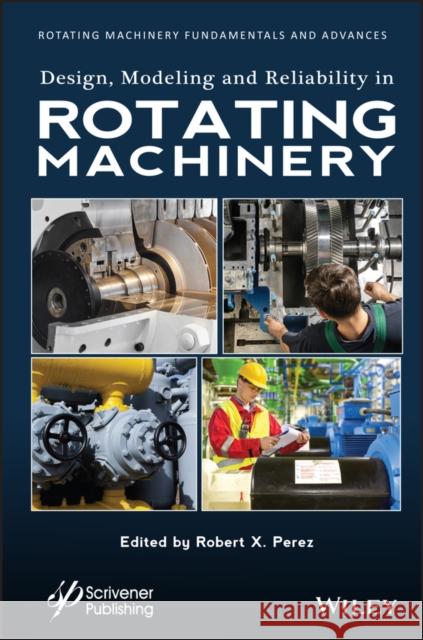Design, Modeling and Reliability in Rotating Machinery » książka



Design, Modeling and Reliability in Rotating Machinery
ISBN-13: 9781119631682 / Angielski / Twarda / 2022 / 384 str.
Design, Modeling and Reliability in Rotating Machinery
ISBN-13: 9781119631682 / Angielski / Twarda / 2022 / 384 str.
(netto: 908,58 VAT: 5%)
Najniższa cena z 30 dni: 950,08
ok. 30 dni roboczych
Bez gwarancji dostawy przed świętami
Darmowa dostawa!
Preface xiiiAcknowledgements xvPart 1: Design and Analysis 11 Rotordynamic Analysis 3By William D. MarscherIntroduction 3Rotor Vibration - General Physical Concepts 4Rotor Vibration - Mathematical Description 6Natural Frequencies and Resonance 6Critical Speed Analysis 10Phase Angle, and Its Relationship to Natural Frequency 15Gyroscopic Effects 16Accounting for Bearings 18Cross-Coupling Versus Damping and "Log Dec" 20Annular Seal "Lomakin Effect" 21Fluid "Added Mass" 23Casing and Foundation Effects 24Lateral Vibration Analysis Methods for Turbomachinery and Pump Rotor Systems 25Manual Methods Single Stage 25Computer Methods 26Forced Response Analysis 30Mechanical Excitation Forces 32Balance 32Fluid Excitation Forces 37Impeller Reaction Forces 37Impeller Active Forces 38Rotordynamic Stability 43Subsynchronous Whirl & Whip 43Stabilizing Component Modifications 47Vertical Turbine Pump Rotor Evaluation 48Conclusions 51Nomenclature 52Acknowledgements 53References 532 Torsional Analysis 57By William D. MarscherIntroduction 58General Concerns in the Torsional Vibration Analysis of Pump and Turbomachinery Rotor Assemblies 58Predicting Torsional Natural Frequencies 59Torsional Excitations 63Torsional Forced Response 68Case History 72Conclusions 73Nomenclature 79Acknowledgements 79References 803 Hydrodynamic Bearings 83By John K. WhalenAPI Mechanical Equipment Standards for Refinery Service 83Bearings 84Hydrodynamic Lubrication 85Tower's Experiments 86Reynolds Equation 88Stribeck Curve 93Journal Bearings 94Dynamic Coefficients 101Tilting Pad Journal Bearings 103Pivot Types 107Lubrication Methods 117Thrust Bearings 120A Note on Thrust Bearing Diameters 122Fixed Geometry Thrust Bearings 122Pivot Types 127Lubrication 127Increasing Load Capacity 130Babbitt 131Polymer-Lined Bearings 132Current and Future Work 134References 1354 Understanding Rotating Machinery Data Trends and Correlations 139By Robert X. PerezPattern Recognition 139Static Versus Dynamic Data 141Trends 142Flat Trends 142Trends with Step Changes 144Upward and Downward Trends 146Cyclic Trends 148Is It the Machine or the Process? 148Correlations 149"Correlation Does Not Imply Causation" 151Combination Trends 154Exponential Growth Trends 155Erratic Trends 160Induced Draft Fan Experiences Unpredictable Vibration 160Erratic Vibration Related to Rotor Instability 161Some Rules of Thumb 1625 An Introduction to Sizing General Purpose Steam Turbines 165By Robert X. Perez and David W. LawhonWhy Do We Use Steam Turbines? 165How Steam Turbines Work 165Steam Generation 167Waste Heat Utilization 168The Rankine Cycle 169General Purpose Steam Turbine Sizing 170General Purpose, Back Pressure, Steam Turbines 170Single Stage Back Pressure Steam Turbine 170Sizing Procedure 171Closing Comments 1856 Making the Business Case for Machinery Upgrades 187By Robert X. PerezPayback Time Examples 190Closing Thoughts 193Part 2: Compressors 1957 Selecting the Best Type of Compressor for Your Application 197By Robert X. PerezExample of How to Convert from SCFM to ACFM 200Compressibility Factor (Z) 200Compressor Selection Example 201Summary 205Addendum 207Demystifying Compressor Flow Terms 207Ideal Gas Law 208Examples of How to Convert from SCFM to ACFM 210Visualizing Gas Flow 211Compressibility Factor (Z) 2128 Compressor Design: Range versus Efficiency 215By James M. SorokesIntroduction 215Critical Parameters/Nomenclature 216Operating Requirements 223Critical Components 225Impellers 225Inlet Guides 232Diffusers 235Return Channels 238Other Components 240Aerodynamic Matching 243Stage Components 243Stage to Stage 245Operating Conditions 246Movable Geometry - Optimizing Range and Efficiency 248Concluding Remarks 251Disclaimer 251Acknowledgements 251References 2529 Understanding Reciprocating Compressor Rod Load Ratings 255By Robert X. PerezIntroduction 255Basic Theory 256Gas Loads 256Piston Rod Loads 260Crosshead Pin Loads 261Crankpin Loads 262History of "Rod Loads" 262Glossary of Terms 265User's Perspective 266Performance Study to Evaluate Compressor Re-Rate 268Combined Load Exceeds Gas Load 269Distorted Pressure Measurements = Distorted Rod Loads 269Conclusions 271Reference 27110 How Internal Gas Forces Affect the Reliability of Reciprocating Compressors 273By Robert Perez, Robert Akins and Bruce McCainGas Loads 274Non-Reversing Gas Loads 277Non-Reversing Rod Conditions Matrix 279Non-Reversing Gas Load Examples 281"One Failure from Disaster" 283Ways to Protect Your Compressor 285Closing Remarks 285Robert Akins 286Acknowledgements 286Part 3: Pumps 28711 Should You Use a Centrifugal Pump? 289By Robert X. PerezNet Positive Suction Head - NPSH 296Ways to Increase the Margin Between the NPSHa and the NPSHr 302Summary 30612 Practical Ways to Monitor Centrifugal Pump Performance 307By Robert X. PerezWhy Use Centrifugal Pumps? 307Head Versus Pressure 309Centrifugal Pump Performance 311Assessing Centrifugal Pump Performance 313Summary 317Addendum 319Determining the Best Two-Parameter Analysis Method for a Centrifugal Pump 31913 Using Electric Motor Horsepower to Protect Centrifugal Pumps Operating in Parallel Flow Applications: A Case Study 325By Robert X. Perez and Glenn EverettThe Problem 325Solution 327Results 331Conclusions 332Addendum 332A Simplified Method of Determining the Efficiency of a Motor-Driven Centrifugal Pump 332The Traditional Analysis Method 333A Simplified Alternative Assessment Method 334Example 33514 Mechanical Seals and Flush Plans 337By Robert X. PerezRecommendations for Optimizing the Service Lives of Mechanical Seals 337Liquid Properties 339Expected Seal Cavity Pressure 340Sealing Temperature 340Liquid Characteristics 340Reliability and Emission Concerns 340Single or Double Seal? 341Seal Flush Plans 342Parting Advice 350About the Editor 351About the Contributors 353Index 357
Robert Perez is a mechanical engineer with more than 40 years of rotating equipment experience in the petrochemical industry. He has worked in petroleum refineries, chemical facilities, and gas processing plants. He earned a BSME degree from Texas A&M University at College Station, an MSME degree from the University of Texas at Austin and holds a Texas PE license. Mr. Perez has written numerous technical articles for magazines and conferences proceedings and has authored five books and coauthored four books covering machinery reliability, including several books also available from Wiley-Scrivener.
1997-2025 DolnySlask.com Agencja Internetowa
KrainaKsiazek.PL - Księgarnia Internetowa









